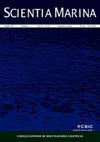坎佩切河岸东部章鱼的潜在生物量和分布(Yucatán,墨西哥)
IF 0.9
4区 生物学
Q4 MARINE & FRESHWATER BIOLOGY
引用次数: 10
摘要
坎佩切河岸(墨西哥尤卡坦)的章鱼渔场被认为是世界第三大渔场。在尤卡坦,有两支舰队瞄准了这一资源:一支手工舰队和一支半工业舰队。手工船队只捕获章鱼,而半工业船队捕获两个物种,O.maya和O.“vulgaris”Type II,因为它在更深的水域(>30m)作业。由于没有关于II型O.vulgaris丰度的信息,因此管理仅基于O.Maya。为了获得有关该物种丰度的信息,在尤卡坦半岛外大陆架东北部地区进行了四次捕鱼研究巡航。应用并比较了四种方法(分层随机法、扫描面积法、地质统计学和加权扫描面积法),以确定研究区域内两种物种的瞬时丰度和生物量。最低潜在生物量是用地统计学方法计算的,其值比其他三种方法低18.5%-36.7%。“vulgaris”II型在5月和7月的生物量最低(37.8±3.36t),12月的最高(189.56±11.6t)。我们的研究结果表明,这两个物种在研究区域的总丰度相似,地理重叠的幅度随着地理位置的不同而全年变化:玛雅O.Maya在大约88°W处占主导地位,而II型O.vulgaris在87°W处向东南方占主导地位。本文章由计算机程序翻译,如有差异,请以英文原文为准。
Potential biomass and distribution of octopus in the eastern part of the Campeche Bank (Yucatán, Mexico)
The octopus fishery on the Campeche Bank (Yucatan, Mexico) is considered the third largest in the world. In Yucatan, two fleets target this resource: an artisanal fleet and a semi-industrial fleet. The artisanal fleet only catches Octopus maya, while the semi-industrial fleet catches two species, O. Maya and O. “vulgaris” Type II, because it operates at deeper waters ( > 30 m). Since there is no information on the abundance of O. “vulgaris” Type II, management is based only on O. Maya. In order to generate information about the abundance of this species, four fishing research cruises were carried out in the northeastern area of the continental shelf off the Yucatan Peninsula. Four methods (a stratified random method, a swept area, geostatistics and a weighted swept area) were applied and compared to determine the instantaneous abundance and biomass of both species in the study area. The lowest potential biomass was calculated with the geostatistical method, with values between 18.5% and 36.7% lower than the other three methods. O. “vulgaris” Type II showed the lowest biomass (37.8±3.36 t) during May and July and the highest (189.56±11.6 t) in December. Our findings revealed that the total abundance of both species was similar in the study area, with a geographic overlap whose amplitude changed throughout the year according to the geographic position: O. Maya dominated at approximately 88°W, while O. “vulgaris” Type II dominated towards the southeast at 87°W.
求助全文
通过发布文献求助,成功后即可免费获取论文全文。
去求助
来源期刊

Scientia Marina
生物-海洋与淡水生物学
CiteScore
2.10
自引率
0.00%
发文量
21
审稿时长
6-12 weeks
期刊介绍:
Scientia Marina is the successor to Investigación Pesquera, a journal of marine sciences published since 1955 by the Institut de Ciències del Mar de Barcelona (CSIC). Scientia Marina is included in the Science Citation Index since 1998 and publishes original papers, reviews and comments concerning research in the following fields: Marine Biology and Ecology, Fisheries and Fisheries Ecology, Systematics, Faunistics and Marine Biogeography, Physical Oceanography, Chemical Oceanography, and Marine Geology. Emphasis is placed on articles of an interdisciplinary nature and of general interest.
 求助内容:
求助内容: 应助结果提醒方式:
应助结果提醒方式:


